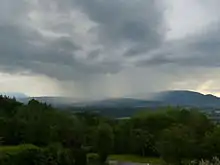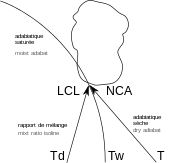Shower (precipitation)
A shower is a mode of precipitation characterized by an abrupt start and end and by rapid variations in intensity. Often strong and short-lived, it comes from convective clouds, like cumulus congestus. A shower will produce rain if the temperature is above the freezing point in the cloud, or snow / ice pellets / snow pellets / hail if the temperature is below it at some point.[1] In a meteorological observation, such as the METAR, they are noted SH giving respectively SHRA, SHSN, SHPL, SHGS and SHGR.[2][3]

Formation

Convection occurs when the Earth's surface, especially within a conditionally unstable or moist atmosphere, becomes heated more than its surroundings and in turn leading to significant evaporation. The raised air parcel in a colder environment at altitude will cool but according to the adiabatic thermal gradient forming clouds, and later precipitation above the lifted condensation level (LCL). Depending on the Convective available potential energy (CAPE), the clouds will be cumulus humilis, cumulus mediocris and then cumulus congestus, the latter giving short-lived precipitation of rain, snow or ice pellets changing in intensity, i.e. showers.[1]
The life cycle of these clouds is fast because the updraft which forms them is most often cut off by the descent of precipitation. In addition, these clouds flow with atmospheric circulation and spend little time above a point on the ground. This explains the variations in intensity and the short duration of the showers. The type of precipitation will depend on the temperature structure in the cloud and below it:
- In winter, when the temperature in the cloud is below freezing (0 °C), snowflakes will be generated:
- On the other hand, raindrops might form in a strong updraft in a convective cloud, even at temperature below freezing in the cloud (Supercooling) and freeze later, giving ice pellet showers.[6]
- Finally, droplets can form and fall in an above freezing layer in other seasons, giving rain showers.
Extreme

If the convection is more intense, it leads to the formation of cumulonimbus clouds which have a very large vertical extension. This permits the displacement of electric charges from the bottom to the top that will create lightning and thunder. The showers associated with this kind of clouds are therefore called thundershowers or thunderstorms. Hail and other violent phenomena are associated with this type of convection.
Showery systems
Showers come from individual clouds as well as from groups of these. In mid-latitude regions, showers are often associated with cold fronts, often found along and behind it. However they can be embedded into a continuous rain episode when there is presence of band of conditional symmetric instability in an otherwise stable air mass. They can also be part of large convection zones called mesoscale convective system such as a squall line.
References
- "Shower". AMS Glossary. American Meteorological Society. Retrieved 2020-01-01.
- Meteorological Service of Canada. "METAR Study Guide". meteocentre.com. Retrieved 2020-01-01.
- Meteorological Service of Canada (2013). MANOBS (PDF). Environment and Climate Change Canada. p. 148. Archived from the original (PDF) on 2013-03-13.
- "Snow pellets". AMS Glossary. American Meteorological Society. Retrieved 2020-01-01.
- "Snow shower". AMS Glossary. American Meteorological Society. Retrieved 2020-01-01.
- "Ice Pellets". AMS Glossary. American Meteorological Society. Retrieved 2020-01-01.